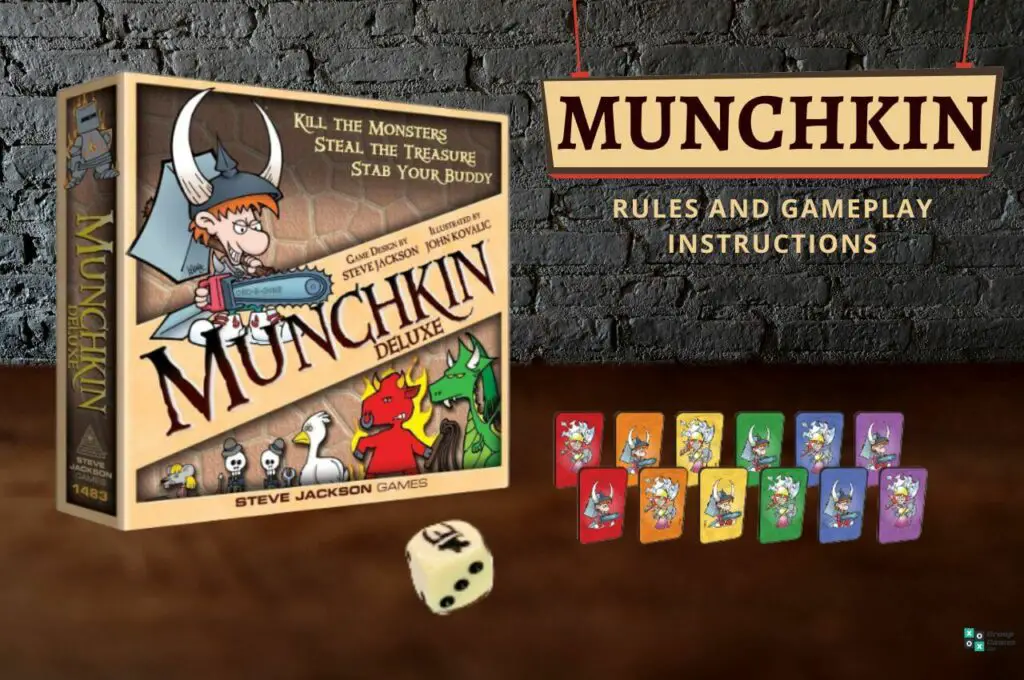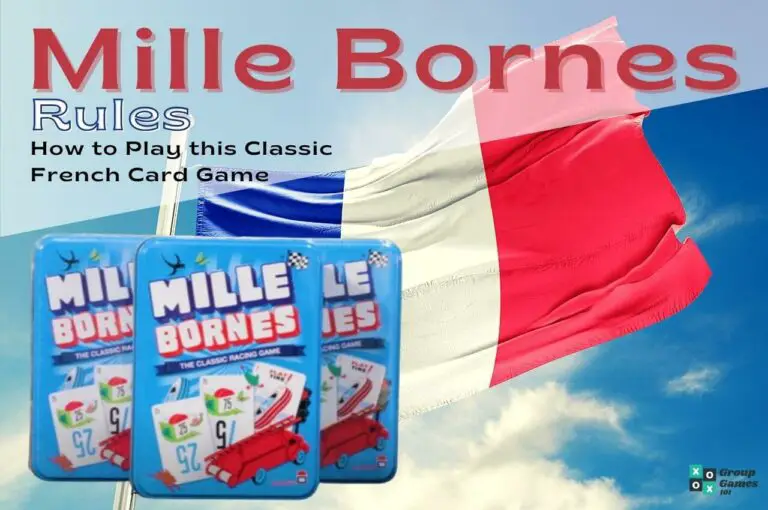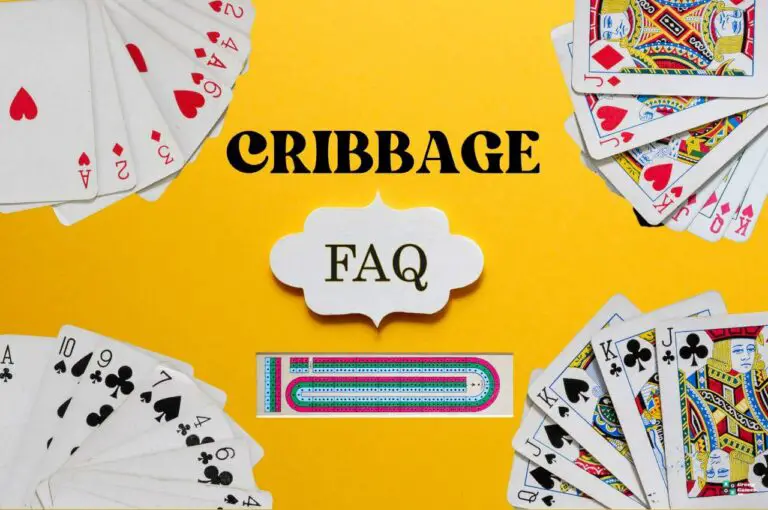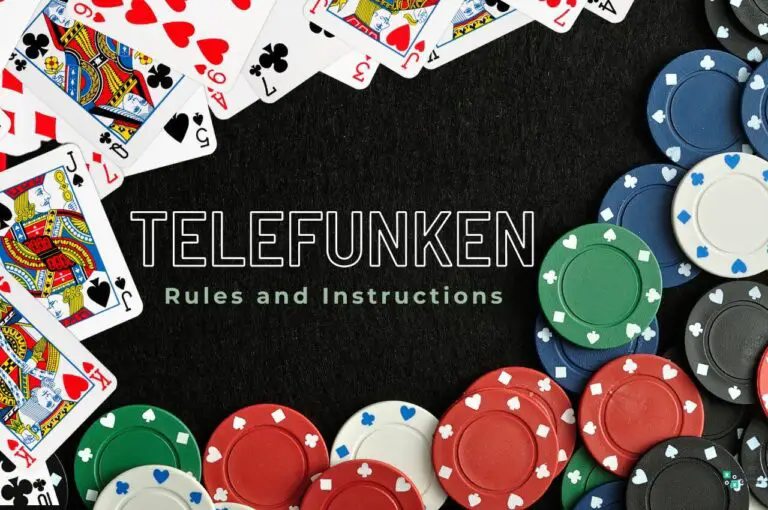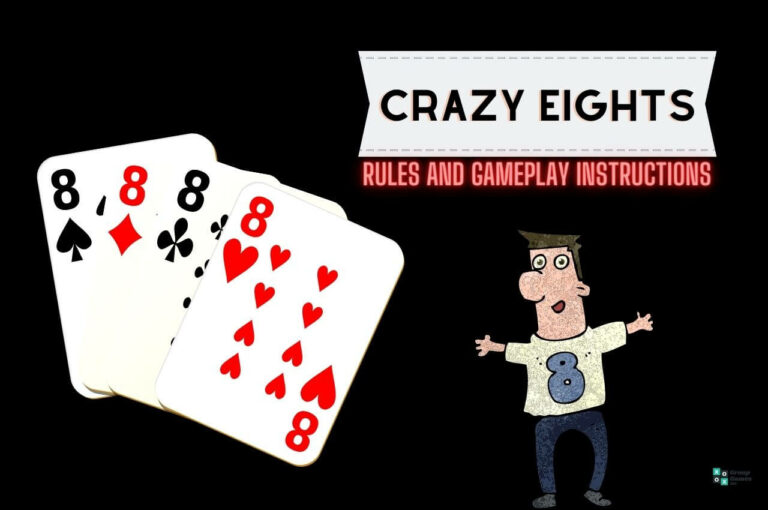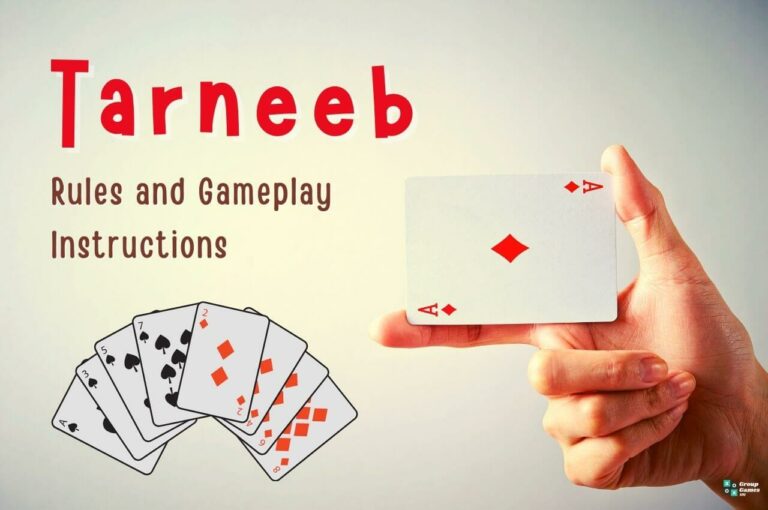If you’re a fan of strategy games, you should definitely enjoy Munchkin. My Munchkin game rules guide explains how to play this game step by step.
Munchkin is a popular board game invented and produced by Steve Jackson, an American designer also responsible for Undead, Zombie Dice, and quite a few other games.
The game was first released in 2001 and became a huge hit. As of 2023, it’s available in 15 language versions, and there are even multiple re-editions and expansion packs available.
The story invites us to a world of monsters and treasures, reminding me of 5 Minute Dungeon (see 5 Minute Dungeon rules) or Red Dragon Inn (check Red Dragon Inn rules).
This Munchkin Game rules guide will cover the following:
- What is Munchkin?
- What you’ll need to play Munchkin
- Munchkin game rules
- How to play Munchkin (video tutorial)
- FAQs
- Other similar games to Munchkin (our guides)
Continue reading for detailed instructions on how to play Munchkin.
What is Munchkin?
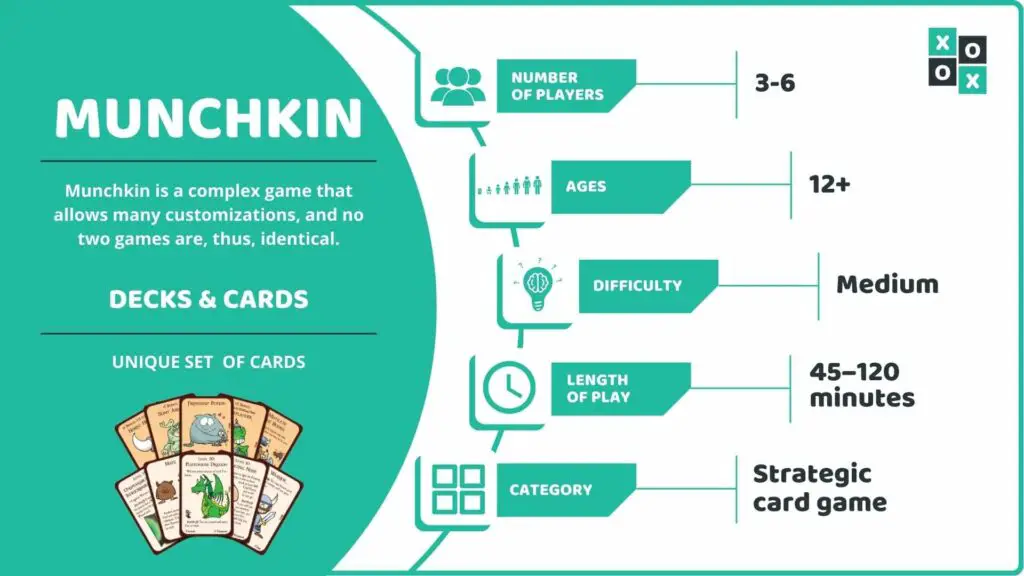
The first and original version of Munchkin was a card game focused on strategic thinking, sneaky tactics, and surprises.
Then, in 2011, Steve Jackson released Munchkin Deluxe, which brought new elements to the game – including the gameboard that helps players track their progress.
Other than that, though, the game’s rules remain pretty much the same: Climb through a ladder of rankings to the top by slaying monsters and stealing their wealth.
Number of Players: 3 to 6
Ages: 12+
Difficulty: Moderate
Length of Play: 45 – 120 minutes
Category: Strategic card & board game
Similar to: 5 Minute Dungeon, Red Dragon Inn, Clank!
Main Objective: Reach Level 10 of your character’s evolution before your opponents.
Why We Love It: Munchkin is a complex game that allows many customizations, and no two games are, thus, identical.
What You’ll Need to Play Munchkin
The game is played with a dedicated Munchkin game set. It contains the following materials:
- 168 playing cards
- 6 standees
- 6 player cards
- gameboard
- set of rules
- die
Munchkin Game Rules and Gameplay
The game of Munchkin turns you into a fantasy character with an appetite for slaying monsters and an ambition to capture valuable treasures.
As the game proceeds, your character evolves, and so do your relationships with the opponents.
Your ultimate goal is to become the first player who reaches the top level.
Starting the Game
First, take out the gameboard and a die and place them in the center of the table.
Next, take out all the playing cards from the box and sort them. There are two types of cards: some have a picture of a door on their back, while the others depict a treasure.
Shuffle them separately and place them face down on the respective zones of the board. Every player draws four cards of each type (8 in total), keeping them in their hand.
The players pick their colors and collect a pair of matching standees. Set one of them on the first space of the board (marked as “1”) and keep the other one in front of you.
Notice that the standees are gender specific, but it does not mean that a female player can only play with a female character. Still, your gender can make a difference in certain situations during the game.
How to Play Munchkin
The game of Munchkin is played over a series of turns proceeding in a clockwise direction, starting with the player who rolls the highest number on the die.
Each turn consists of three phases:
- 1. Open the door
- 2. Look for a trouble
- 3. Charity
1. Open the door
Draw one card from the door deck. There are several card types you can encounter:
Race & Class cards
All the players start equal. Their initial characters are human, and they stand side by side on the first field of the board without any possessions.
However, as you proceed, you can change the type and features of your character, which may, in return, help you achieve the desired goal.
This can be done through the Race or Class cards (check for the “Race” or “Class” inscription in the bottom right corner of the card), which define your skills and interactions.
If you have some of these cards in hand, you can start modifying your character even before the game begins:
Just place the race and/or class cards you want to activate on the table in front of you, keeping them face up for everyone to see.
You can change your character later again, but you can always have just one active race and one active class at any time.
Example: If you have an “Elf” race card and a “Warrior” class card, you can turn your classless human character into an Elf warrior, etc.
Item cards
Besides changing your character’s race or class, you can also improve their abilities with Item cards, including things like “pointy hat of power” or “bow with ribbons.”
Each item has its value in gold pieces noted on the bottom right. Some are free (“no value”).
To equip your character with any of the items, just place the Item card in front of you next to your character/class cards.
You can use numerous Item cards at once. There are some restrictions, though:
- Body location in the bottom left corner (e.g., two hands) indicates how the items are worn. You can only have one of each type equipped at any time. You can use two items for one hand, though, as you have two hands.
- Some items are intended/restricted for a specific race. For example, a “bow with ribbon” is usable only by elves, whereas “mithril armor” is not usable by wizards, etc. This information can be found at the top of a restricted Item card.
- Some items can also be useable only by a specific gender. For instance, the “gentleman’s club” can only be used if you have a male standee on the gameboard.
Despite the restrictions, any character can possess and carry any item, which also comes with benefits. Turn the card sideways to indicate that you carry an object without using it.
There are some items, however, that you also cannot carry in larger quantities:
- You can only carry one item marked as “Big” (bottom left) at a time.
- All items not explicitly marked as “Big” are considered small – you can carry as many of them as you want.
Trading and selling
Unless you are actively involved in combat, you can also trade your items with other players (who are not in combat either) anytime during the game.
You can trade any of your cards on the table but not those in your hand. Traded cards must also stay on the table once they change owners.
When on your turn (and not in combat), you may also sell your items worth individually or in total 1,000 pieces of gold.
In return, you can go one Level up – or even multiple Levels up if your items are worth 2,000, 3,000, etc..!
Curse cards
- If it says “Curse,” you are having bad luck. Follow the instructions on the card, such as “Lose a level” (return one level backward).
- Some curses may follow you for the rest of the game, such as a “chicken on your head” subtracting one from all your future die rolls. Others are just one-offs.
- Discard a used curse card on the designated space on the board facing up.
Treasure cards
Treasure cards can only be earned through battles with Monsters (I’ll detail this shortly). These cards contain rewards that can come in handy.
- You can play a Treasure card immediately or save it for later. Some cards can be played “anytime” – even during the fight or out of turn. However, most are usable only once.
- Some treasures can be used to defeat a monster without killing it (e.g., turn it into a parrot). As a result, you can collect the Monster’s treasure but don’t go up a level.
- Once you’ve used the card, put it in the designated place for a Treasure discard pile.
- Besides gaining an advantage from the cards, you can also use them to help others – or even to help monsters defeat your opponents!
Monster cards
When you uncover a Monster card, you must fight the Monster by comparing your strengths. The stronger one wins.
- The strength is defined by a character’s level and any equipped items affecting it (note that you can’t equip new items during the fight unless a card explicitly allows it).
- Example: If you’re on Level 1, but you have equipped an item that says “+4 bonus”, so your total strength is 5.
If you win the battle…
- …you move one level up and draw as many Treasure cards as indicated on the Monster card (see more details below).
- If you’re weaker than the Monster (or equal), you can lose the battle – unless you get some help from your opponents!
- You can ask any player to help, offering something in return: a “Go Up a Level” card, an Item card you carry, or part of the Monster’s treasure when you win.
- If a player accepts your request (only one player can help you in each battle), they provide you with all the strengths and items of their own character.
- Such a helper should keep in mind, though, that any effects of the Monster will apply to them during the battle just like they would to the original player.
- Yet, the helper does not receive any rewards for the victory – they don’t go up one level (the original player does) or get a piece of the treasure unless agreed upon upfront.
- Some cards can also force a player to accept a request for help, but only up to Level 8. No one can force your opponent to help you advance from Level 9 to 10 and win.
- Other cards may deploy multiple monsters into a battle at once (particularly those Undead). In this case, you must defeat all those monsters to get any rewards.
If you lose the battle…
- Despite all the efforts, if you lose the fight with a Monster, you do not receive any treasures nor advance one Level up.
- Moreover, you must now also try to escape from the Monster by rolling the die!
- Rolling five or more means you escape.
- If you roll a smaller number, the “Bad stuff” section of the Monster card’s description activates.
- Typically, the penalty involves losing some items. But sometimes, you can also die, which means that:
- You can keep your equipped character, race, and curse cards.
- Put down all the cards in your hands alongside your equipped Item cards.
- Each opponent can pick one of your items, keeping it in their hands.
- Any remaining cards will be discarded.
- On your next turn, draw four cards from each pile like at the beginning. You can return to the game at your previous Level, but you start empty-handed.
If you’ve had a helper when you lost the fight, they must also try to escape the Monster by rolling the die for themselves.
Describing all the cards and possibilities in the game would take ages, so I am not going into any more detail here. After all, the description on the cards is usually pretty self-explanatory.
Just note that whenever you run out of any deck, simply shuffle the discarded cards of the same type and reuse them.
Let’s move to the next phase of the game:
2. Look for a trouble
A player would get to the Look for a trouble phase of the game ONLY if they did not fight a monster in the previous phase (if you did, simply skip this step).
These players now have their chance to:
- Play a Monster card from their hand and fight it just like I’ve described earlier, OR
- “Loot the room” by drawing another card from the Door deck and keeping it in hand.
Once you’re ready, proceed to the final phase of your turn.
3. Charity
If you have more than five cards in hand at this point, you must get rid of them by donating them to your least successful opponent (the one who’s on the lowest Level).
In case of a tie, divide the cards among the weakest players as fairly as possible. If you are the weakest player, discard any cards above five from your hand.
When you’re done with the 3rd stage of the turn, the player sitting to your left takes their turn. The game proceeds until one of the players reaches the final field of the gameboard.
Munchkin Scoring
In Munchkin, players don’t collect any points. Instead, they move up the ladder of rankings until reaching Level 10. Whoever accomplishes this first wins the game.
How to Play Munchkin Card Game – Video Tutorial
Munchkin Card Game Frequently Asked Questions
Can you win Munchkin using the “Go Up a Level” card?
No. You can use this card to advance in any other game stage, but once you’re already in Level 9, you can proceed to Level 10 only by slaying a monster.
Can you get rid of a curse in Munchkin?
Yes! Each card with a curse includes instructions on how to remove the curse. It’s usually connected to the use of some other card or item.
What if you lose a level in Munchkin while you’re at Level 1?
Your character cannot have a lower level than 1, so if you draw a curse card that tells you to lose a level while you’re at Level 1, it has no effect on you.
What does the special symbol on the Munchkin die mean?
You may notice that the die included within the Munchkin game set has a specific symbol on one of its sides. This symbol stands for the value “one.”
Other Similar Games to Munchkin (Our Guides)
If you like this original strategy game, check out our guides to some interesting Munchkin alternatives:
- 5 Minute Dragon rules
- Red Dragon Inn rules
- Sheriff of Nottingham rules
- Res Arcana rules
- Carcassone rules
- Clank! rules
- Cutthroat Caverns rules (guide coming soon)

